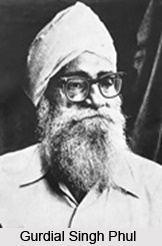 Gurdial Singh Phul was a Punjabi dramatist of thirty full-length plays and twelve one-act anthologies. His work can be divided into cycles. First came problem plays in which one or the other social issue figures as illustration. `Couple` in 1944 and Sathi i.e. `Comrade` in 1949 emphasize messages which do not require subtlety of characterization, plot construction, and style. Typical themes like landlordism, starvation, and prostitution draw attention to the enormity of these problems.
Gurdial Singh Phul was a Punjabi dramatist of thirty full-length plays and twelve one-act anthologies. His work can be divided into cycles. First came problem plays in which one or the other social issue figures as illustration. `Couple` in 1944 and Sathi i.e. `Comrade` in 1949 emphasize messages which do not require subtlety of characterization, plot construction, and style. Typical themes like landlordism, starvation, and prostitution draw attention to the enormity of these problems.
The second cycle comprises plays derived from the lives of the Sikh Gurus and the adventures of martial heroes, notably Jin sach palle hoi i.e. `Those with Truth on Their Side` in 1969, Tatti vau na lagai i.e. `No Hot Wind Scorches` in 1970, Asin dun savai hoi i.e. `We Grow Manifold` in 1972, and Nanak nadri nadar nihal i.e. `Nanak, Bestower of Grace` in 1973. These commemorate the sublime vision that the Gurus preached to dispel darkness from people`s minds and celebrate the heroism that Sikhs in the seventeenth century displayed while fighting Mughal forces. Since their awareness of Sikh faith and history reflects only what common lore recorded, they did not chalk out any new direction for Punjabi theatre. Gurdial Singh Phul died on 20th October 1989.
This article is a stub. You can enrich by adding more information to it. Send your Write Up to content@indianetzone.com




















